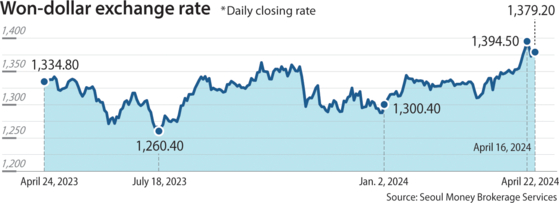Won expected to hold steady against dollar with contained Middle East conflict
![Electronic display boards at Hana Bank in central Seoul show Korea’s stock and foreign exchange markets on Monday. [NEWS1]](https://koreajoongangdaily.joins.com/data/photo/2024/04/22/f01cb702-7821-4b23-96fc-3db9bf355793.jpg)
Electronic display boards at Hana Bank in central Seoul show Korea’s stock and foreign exchange markets on Monday. [NEWS1]
The Korean won has steadied against the U.S. dollar after nose-diving as tensions escalated in the Middle East, and is now expected to remain stable for some time so long as the war does not expand, according to analysts.
The local currency remains weak, trading at 1,379.2 on Monday, down 6 percent from the beginning of the year. But the avoidance of all-out war between Iran and Israel and the government’s verbal intervention on the foreign exchange market last week after the won reached a 17-month low have arrested the fall.
“The won-dollar exchange rate is expected to stay steady for the time being, as the war in the Middle East appears to have plateaued” after Iran downplayed Israel’s retaliatory drone strikes against it, said Park Sang-hyun, an analyst at Hi Investment & Securities.
“The won is expected to stay flat in the current range until oil prices fall and expectations for an interest rate cut by the U.S. Federal Reserve recovers, which will lower U.S. Treasury yields and weaken the dollar.”

Park expects the won to move between 1,350 and 1,410 won against the greenback this week.
Oil prices are of particular importance to Korea as Asia’s fourth largest economy relies on imports to meet demand for its fossil fuel supply due to a lack of international oil or natural gas pipelines.
Brent crude oil, the international benchmark, fell to around $86 per barrel on Monday after crossing $90 earlier this month.
The won broke 1,400 to the dollar last week following armed conflict between Iran and Israel, the weakest since November 2022, when it hit 1,413.5 mid-trading. The 1,400-won threshold was previously reached during the 1997 Asian financial crisis and the 2008 global financial crisis.
The government issued a verbal intervention and the financial chiefs of Korea, the United States and Japan pledged in a trilateral meeting in Washington last week to “consult closely on foreign exchange market developments,” while acknowledging serious concerns about the sharp depreciation of the won and the yen.
Bank of Korea Gov. Rhee Chang-yong said relative stability in geopolitical tensions in the Middle East will confer stability on the won-dollar exchange rate.
“There will not be many difficulties in managing the exchange rate if the war does not expand further,” Rhee told reporters in a press conference held on the sidelines of the International Monetary Fund and Group of 20 finance leaders’ spring meetings in Washington last Friday. The exchange rate will stabilize as long as oil prices do not soar or the Strait of Hormuz is shut down, he added.
Rhee told CNBC last Tuesday that the movement of the won-dollar exchange rate is “a little excessive judging from what could be justified by market fundamentals.”
A structural issue is also strengthening the dollar.
“The value of the dollar in the long term is determined by a matter of expansion or contraction of investment toward the United States,” said Ha In-hwan, an analyst at KB Securities in a report on Monday. “At this point, the strengthening of the dollar cannot be easily resolved as investment toward the United States is expanding due to the country’s reshoring policy.”
The United States is also urging multinational businesses to expand investment in the country by awarding billions of dollars in subsidies.
The U.S. dollar index — a measure of its value relative to a basket of six foreign currencies that include the euro, the pound and the yen — is at around 106, up more than 4 percent this year.
“If the won-dollar exchange rate does not stabilize, the government will have to deploy additional tools to respond to the market volatility, like selling dollars in the foreign exchange market,” added Hi Investment & Securities' Park.
Additional factors expected to affect value of the dollar are U.S. gross domestic product data for the first quarter, scheduled to be released on April 25, followed by the Personal Consumption Expenditures Price Index on April 26.
A faster pace of economic growth and inflation will suggest that the Federal Reserve would be in no rush to cut interest rates, keeping the dollar strong.
BY JIN MIN-JI, SHIN HA-NEE [jin.minji@jongang.co.kr]










with the Korea JoongAng Daily
To write comments, please log in to one of the accounts.
Standards Board Policy (0/250자)